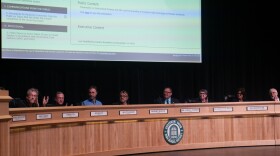For the third year in a row, California’s plan to expand food assistance to undocumented adults 55 and older faced the risk of delay, this time through a budget clause that could have indefinitely stalled the rollout.
A clause in Governor Gavin Newsom’s May budget would have made growing the program contingent on the state’s fiscal outlook — a move that advocates feared could delay it indefinitely. But advocates and lawmakers successfully fought to remove a “trigger clause” in the final budget in June, preserving the expansion timeline.
The California Food Assistance Program, or CFAP, is still on track to begin serving undocumented adults 55 and older in October 2027. The California Department of Social Services estimates that once implemented, the CFAP expansion could help more than 75,000 residents across the state.
But supporters say the fight is far from over.
Democratic Assemblymember Celeste Rodriguez said she’s heard from constituents in the northeast San Fernando Valley who are too afraid to go to the grocery store, even when they can afford it.
“At this point, exposure to [the] outside seems to be dangerous,” she said. “So the community’s really showing up right now to fill the holes that our government has created.”
Rodriguez has introduced legislation to make it easier for immigrants to get the food they need. She was also among the lawmakers who pushed back on the budget restriction that could have delayed the expansion.
“No one should go hungry in our state regardless of their immigration status,” the San Fernando lawmaker said. “It’s so critical that we ensure people have nutritious, available food, especially as these cuts to health care are occurring.”
The CFAP expansion was originally scheduled to launch in 2025, but Newsom delayed it to 2027 during last year’s May Revision. Supporters like Jackie Mendelson, a policy advocate with Nourish California, are bracing for more political fights..
“We still have two more budget cycles to fight for a re-commitment of this October 2027 expansion and to continue to push for an expansion to all ages, regardless of immigration status,” Mendelson said.
The program buildup has come under attack from fiscal conservatives and taxpayer groups in the past for its $132 million annual price tag, especially as the state faces a multi-billion-dollar budget deficit.
The Howard Jarvis Taxpayers Association frequently weighs in on government spending and previously argued that expanding CFAP benefits was a bad idea, noting that food insecurity is “a symptom of failed policies,” according to CalMatters.
Mendelson argued the added cost is modest compared to the long-term benefits.
“It seems like a large number, but over time it should actually save the state money in providing healthy and life-saving food assistance,” she added.
Mendelson said delays also hurt other immigrants dealing with food insecurity still excluded from the program, many of whom turn to local nonprofits and food banks already overwhelmed.
“When people don’t have the ability to purchase the foods they want and need, then definitely the need does skyrocket for these food pantries,” she said.
And not everyone feels safe using them. According to Mendelson, fears of immigration enforcement are keeping some immigrants away from public food distribution sites altogether.
“What we’ve heard from many of our partners is that attendance has really declined within high-immigrant communities in these food pantry and food access spaces because of immigration enforcement fears,” she said.
Kevin Buffalino, spokesperson for the Sacramento Food Bank, said the organization is struggling to keep up.
“We’re doing everything we can to meet that demand, but our resources are certainly starting to stretch thin, especially if federal cuts continue,” he said. “As we look ahead [to] 2026 and beyond, we may need to start making some tough decisions about the amount of food that we’re providing, the folks who are coming to us [for]services, or maybe the variety of food that we’re providing.”
That’s a problem in a region where food insecurity continues to climb. Buffalino said Sacramento County has higher rates of hunger than the state and national averages. The food bank estimates that more than a quarter of county residents — about 442,000 people — are at risk of hunger
“They’re eligible for certain services like CalFresh, food assistance programs, and they’re having to make really tough decisions between how they’re going to stretch their budget in order to support their families,” he said.
Buffalino said that’s why programs like CFAP are essential.
“Neither program can do it alone,” he added. “It's a food safety net. So it's really important that we all work together to plug the gaps and make sure that everyone has enough food to feed themselves and feed their families.”
For now, food banks and immigrant advocates say they’ll keep pushing, both to preserve the 2027 rollout and to make sure no Californian is left without food.







